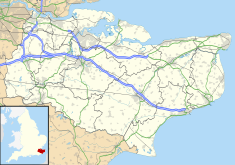Church of St. Martin, Canterbury
| Church of St Martin | |
|---|---|

St Martin's Church
|
|
| Location | Canterbury, Kent, England |
| Coordinates | 51°16′40.76″N 1°5′37.77″E / 51.2779889°N 1.0938250°ECoordinates: 51°16′40.76″N 1°5′37.77″E / 51.2779889°N 1.0938250°E |
| Official name: Canterbury Cathedral, St Augustine's Abbey, and St Martin's Church | |
| Type | Cultural |
| Criteria | i, ii, vi |
| Designated | 1988 (12th session) |
| Reference no. | 496 |
| State | United Kingdom |
| Region | Europe and North America |
|
Listed Building – Grade I
|
|
| Official name: Church of St Martin | |
| Designated | 28-Feb-1952 |
| Reference no. | 1242166 |
The Church of St Martin in Canterbury, England, situated slightly beyond the city centre, is the first church founded in England, the oldest parish church in continuous use and the oldest church in the entire English-speaking world. As such, it is recognised, along with Canterbury Cathedral and St Augustine's Abbey, as part of a World Heritage Site. Since 1668 the church has been part of the benefice of St Martin and St Paul Canterbury. Both St Martin's and nearby St Paul's churches are used for weekly services. The current rector of the parish is the Reverend Mark Richard Griffin.
St Martin's was the private chapel of Queen Bertha of Kent in the 6th century before Augustine arrived from Rome. Queen Bertha was a Christian Frankish princess who arrived in England with her Chaplain, Bishop Liudhard. King Æthelberht of Kent, her pagan husband, allowed her to continue to practise her religion by renovating (ca. AD 580) an existing church which the Venerable Bede says had been in use in the late Roman period but had fallen into disuse. As Bede specifically names it, this church was dedicated to Saint Martin of Tours, a city located near where Bertha grew up.
Upon Augustine's arrival he used St Martin's as his mission headquarters, immediately enlarging it (AD 597), and King Æthelberht was soon baptised here. With the quickly subsequent establishments of Canterbury Cathedral and St Augustine's Abbey, St Martin's lost prestige but retains its priority and historical importance.
Shortly before 1844, a hoard of gold coins which may date from the late 6th century was found in the churchyard, one of which is the Liudhard medalet, which bears an image of a diademed figure with a legend referring to Liudhard.
Local finds prove that Christianity did exist in this area of the city at the time, and the church contains many reused Roman bricks or spolia, as well as complete sections of walls of Roman tiles. At the core of the church the brick remains of a Roman tomb were integrated into the structure. Several sections of walls are clearly very early, and it is possible that a blocked square-headed doorway in the chancel was the entrance to Bertha's church, while other sections of wall come from the period after the Gregorian mission in the 7th or 8th centuries, including most of the nave. The apse that was originally at the east end has been removed. The tower is much later, in Perpendicular style. The church is a Grade I listed building.
...
Wikipedia

